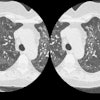Radiology 1996 Feb;198(2):371-375
Risk of pneumothorax in CT-guided transthoracic needle aspiration biopsy of the lung.
Kazerooni EA, Lim FT, Mikhail A, Martinez FJ
Department of Radiology, University of Michigan Medical Center, Ann Arbor 48109-0326, USA.
PURPOSE: To determine risk factors for pneumothorax and chest tube placement associated with computed tomography (CT)-guided transthoracic needle aspiration biopsy (TNAB) of the lung. METHODS: One hundred twenty-one consecutive CT-guided TNAB procedures were performed in 117 patients. Patient age, sex, number of needle passes and pleural planes traversed, lesion size, distance of lesion from the pleura, and results of pulmonary function tests were analyzed as single and multiple dependent variables for pneumothorax and chest tube placement. RESULTS: Pneumothorax occurred in 54 of 121 procedures (44.6%); a chest tube was required in 18 cases (14.9%). Increased lesion depth was the most significant predictor of pneumothorax (P = .002). Smaller lesion size also correlated with increased risk of pneumothorax (P = .04). Among patients with pneumothorax, a significantly higher frequency of chest tube placement was seen in those with severe obstructive lung disease, as measured by percentage of predicted FEV1 (forced expiratory volume in 1 second) (51% in patients requiring a chest tube vs 81% in those not requiring a chest tube, P = .006) and FEV1/FVC (forced vital capacity) (x100) (45% vs 66%, P = .001).
CONCLUSION: Increased lesion depth and smaller lesion size correlated strongly with the development of pneumothorax. Once pneumothorax occurred, chest tube placement related to the severity of the patient's obstructive lung disease.
PMID: 8596834, MUID: 96148784






